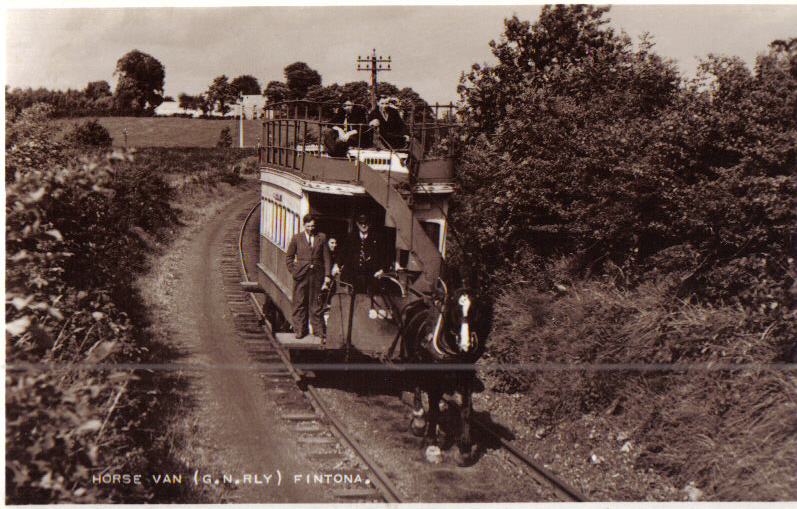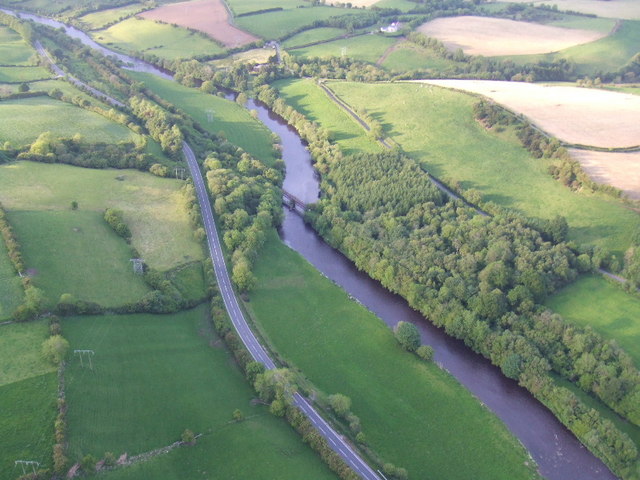|
Fintona
Fintona (; ), is a village and townland in County Tyrone, Northern Ireland. Its population at the 2011 Census was 1,164. Name and etymology Fintona is derived Phonetics, phonetically from the Irish name of the area, ''Fionntamhnach''; this is often translated to mean "white field" however other meanings have been recorded due to various English translations for "fionn" and "tamhnach". "Fionn" may refer to a colour that is described as white, bright, blonde or fair-coloured, while "tamhnach" may refer to a field, clearing, oasis, grassy upland or arable place in a mountain. In the past, the English spelling of the area has varied, with ''"Findonagh"'' in use as recently as 1937 in Church of Ireland documents, while ''"Fentonagh"'' and ''"Fintonagh"'' were also in use in the 19th century. The current spelling of Fintona has been recorded as first used in 1774. History The local area has been known to have had human activity for around 4000 years; there are many burial places, s ... [...More Info...] [...Related Items...] OR: [Wikipedia] [Google] [Baidu] |
Fintona Railway Station
Fintona railway station served Fintona in County Tyrone in Northern Ireland Northern Ireland ( ; ) is a Countries of the United Kingdom, part of the United Kingdom in the north-east of the island of Ireland. It has been #Descriptions, variously described as a country, province or region. Northern Ireland shares Repub .... History The Londonderry and Enniskillen Railway opened the station on 5 June 1853. From 1856, mainline services were withdrawn, and the station was a branch line from Fintona Junction railway station. Most passenger services on this branch line were provided by a horse-drawn tram car. It was taken over by the Great Northern Railway (Ireland) in 1883. It closed on 1 October 1957. Routes References Disused railway stations in County Tyrone Railway stations in Northern Ireland opened in 1853 Railway stations in Northern Ireland closed in 1957 {{Ireland-railstation-stub ... [...More Info...] [...Related Items...] OR: [Wikipedia] [Google] [Baidu] |
Great Northern Railway (Ireland)
The Great Northern Railway (Ireland) (GNR(I), GNRI or simply GNR) was an Irish gauge () railway company in Ireland. It was formed in 1876 by a merger of the Irish North Western Railway (INW), Northern Railway of Ireland, and Ulster Railway. The governments of Ireland and Northern Ireland jointly nationalised the company in 1953, and the company was liquidated in 1958: assets were split on national lines between the Ulster Transport Authority and CIÉ, Córas Iompair Éireann. Foundation The Ulster, D&D and D&BJct railways together formed the main line between Dublin and Belfast, with the D&BJct completing the final section in 1852 to join the Ulster at . The GNRI's other main lines were between Derry and and between Omagh and Portadown. The Portadown, Dungannon and Omagh Junction Railway together with the Londonderry and Enniskillen Railway enabled GNRI trains between Derry and Belfast to compete with the Belfast and Northern Counties Railway, and both this and the Dundalk rou ... [...More Info...] [...Related Items...] OR: [Wikipedia] [Google] [Baidu] |
Fintona Junction Railway Station
Fintona Junction railway station served Fintona in County Tyrone in Northern Ireland. The Londonderry and Enniskillen Railway opened the station on 1 May 1856. It was taken over by the Great Northern Railway (Ireland) The Great Northern Railway (Ireland) (GNR(I), GNRI or simply GNR) was an Irish gauge () railway company in Ireland. It was formed in 1876 by a merger of the Irish North Western Railway (INW), Northern Railway of Ireland, and Ulster Railway. Th ... in 1883. It closed on 1 October 1957. References Disused railway stations in County Tyrone Railway stations in Northern Ireland opened in 1856 Railway stations in Northern Ireland closed in 1957 {{Ireland-railstation-stub ... [...More Info...] [...Related Items...] OR: [Wikipedia] [Google] [Baidu] |
Londonderry And Enniskillen Railway
The Londonderry and Enniskillen Railway (L&ER) was an Irish gauge () railway in Ireland. Construction and opening The Londonderry and Enniskillen Railway was incorporated by the ( 8 & 9 Vict. c. xcviii). Construction began at Derry and followed the west bank of the River Foyle southwards to Strabane, which was reached in 1847. The L&ER's terminus in Derry was station on the west bank of the River Foyle. The line reached its summit at Fintona, County Tyrone, in 1853. Its final extension was from , descending southwestwards to its terminus at , reached in 1854. Fintona Junction was just north of the town of Fintona, leaving the short stretch from the Junction to the town as a small branch line. In 1859 the Dundalk and Enniskillen Railway (D&ER) reached Enniskillen, connecting the D&ER with Dundalk on the Irish Sea. Omagh became a junction in September 1861 when the Portadown, Dungannon and Omagh Junction Railway reached it from the east. The Ulster Railway worked the ... [...More Info...] [...Related Items...] OR: [Wikipedia] [Google] [Baidu] |
Donacavey
Donacavey (), sometimes spelt Donaghcavey, is a townland, civil parish and ecclesiastical parish in County Tyrone, Northern Ireland. The civil parish is split between the historic baronies of Clogher and Omagh East, with the townland in the Clogher barony. The civil parish contains the village of Fintona. Townlands There are 89 townlands in the civil parish of Donacavey. A Aghadreenan, Aghafad, Agharonan, Annaghbo, Annaghmurnin, Ardatinny & Attaghmore B Baronagh, Belnagarnan, Blackfort C Carnalea, Carnarousk, Carryglass, Castletown, Cattor, Cavan, Corbally, Corrashesk, Cranny, Crocknafarbrague & Cumber D Derrybard, Donacavey, Draughton, Drumlagher, Drummond, Drumwhisker, Dundivin Glebe, Dungoran, Dunnamona & Dunnamona Glebe E Ecclesville Demesne, Edenafogry, Edenasop East, Edenasop West & Edenatoodry F Fallaghearn, Feenan, Fintona & Freughmore G Gargrim, Garvallagh, Glennan & Gulladoo K Kilcootry, Kilgort, Killyberry, Killyliss & Killymoonan L Lackagh, Legamaghery, Lega ... [...More Info...] [...Related Items...] OR: [Wikipedia] [Google] [Baidu] |
Ulster Transport Museum
Both the Ulster Folk Museum and Ulster Transport Museum are situated in Cultra, Northern Ireland, about east of the city of Belfast. Now operating as two separate museums, the Folk Museum endeavours to illustrate the way of life and traditions of the people in Northern Ireland, past and present, while the Transport Museum explores and exhibits methods of transport by land, sea and air, past and present. The museums rank among Ireland's foremost visitor attractions and is a former Irish Museum of the Year. The location houses two of four museums included in National Museums NI. Folk Museum History Authorised by the Ulster Folk Museum Act (Northern Ireland) 1958, the museum was created to preserve a rural way of life in danger of disappearing forever due to increasing urbanisation and industrialisation in Northern Ireland. The site the museum occupies was formerly the estate of Sir Robert Kennedy and was acquired in 1961. The museum opened to the public for the first time t ... [...More Info...] [...Related Items...] OR: [Wikipedia] [Google] [Baidu] |
Tram
A tram (also known as a streetcar or trolley in Canada and the United States) is an urban rail transit in which Rolling stock, vehicles, whether individual railcars or multiple-unit trains, run on tramway tracks on urban public streets; some include segments on segregated Right-of-way (property access), right-of-way. The tramlines or tram networks operated as public transport are called tramways or simply trams/streetcars. Because of their close similarities, trams are commonly included in the wider term ''light rail'', which also includes systems separated from other traffic. Tram vehicles are usually lighter and shorter than Main line (railway), main line and rapid transit trains. Most trams use electrical power, usually fed by a Pantograph (transport), pantograph sliding on an overhead line; older systems may use a trolley pole or a bow collector. In some cases, a contact shoe on a third rail is used. If necessary, they may have dual power systems—electricity in city stre ... [...More Info...] [...Related Items...] OR: [Wikipedia] [Google] [Baidu] |
County Tyrone
County Tyrone (; ) is one of the six counties of Northern Ireland, one of the nine counties of Ulster and one of the thirty-two traditional counties of Ireland. Its county town is Omagh. Adjoined to the south-west shore of Lough Neagh, the county covers an area of , making it the largest of Northern Ireland's six counties by size, and the second largest county in Ulster after Donegal. With a population of 188,383 as of the 2021 census, Tyrone is the 5th most populous county in both Northern Ireland and Ulster, and the 11th most populous county on the island of Ireland. The county derives its name and general geographic location from Tír Eoghain, a Gaelic kingdom under the O'Neill dynasty which existed until the 17th century. Name The name ''Tyrone'' is derived from the Irish , meaning 'land of Eoghan', the name given to the conquests made by the from the provinces of and Ulaid. Historically, it was anglicised as ''Tirowen'' or ''Tyrowen'', which are closer to the Irish ... [...More Info...] [...Related Items...] OR: [Wikipedia] [Google] [Baidu] |
West Tyrone (UK Parliament Constituency)
West Tyrone is a United Kingdom constituencies, parliamentary constituency in the House of Commons of the United Kingdom. The current MP is Órfhlaith Begley, a member of Sinn Féin, who has represented the constituency since the 2018 West Tyrone by-election, 2018 by-election. Constituency profile The seat is rural and includes the towns of Strabane and Omagh. Boundaries Since the constituency's creation in 1997, it has consisted of the territory of the former Districts of Omagh and Strabane. There were major local government boundary changes in 2015, but the constituency boundaries remained unchanged. The seat was created in a boundary review conducted in 1995 and was predominantly made out of the western half of the old Mid Ulster (UK Parliament constituency), Mid Ulster constituency – indeed it contains more of the old Mid Ulster than the current seat of that name. It also contains parts of the old Foyle (UK Parliament constituency), Foyle constituency. *Artigarvan; Bal ... [...More Info...] [...Related Items...] OR: [Wikipedia] [Google] [Baidu] |
Clogher (barony)
Clogher is a barony in County Tyrone, Northern Ireland. It is bordered by four other baronies in Northern Ireland: Omagh East to the north; Dungannon Lower to the east; Magherastephana to the south; and Tirkennedy to the south-west. It also borders two baronies in the Republic of Ireland: Trough and Monaghan both to the south-east. In the eighteenth century Clogher barony was sometimes called Upper Dungannon, by contrast with the then barony of Dungannon; it is not to be confused with the modern Dungannon Upper barony created by the 1837 subdivision of Dungannon barony. History The barony of Clogher was a territory formerly known as Kinel Ferady, an anglicisation of a branch of the Cenél nEóghain, the Cenél Fearadhaigh, meaning ''kindred/descendants of Ferry''. This territory was divided into two ancient districts. The Mac Cathmhaoil (, '' Campbell'', ''MacCawell'', ''MacCall'') were the leading sept of the Cenél Fearadhaigh, and one of the seven powerful septs sup ... [...More Info...] [...Related Items...] OR: [Wikipedia] [Google] [Baidu] |
Approach To Fintona - Geograph
{{disambiguation ...
Approach may refer to: Aviation *Visual approach *Instrument approach *Final approach Music * ''Approach'' (album), by Von Hertzen Brothers * ''The Approach'', an album by I:Scintilla Other uses *Approach Beach, a gazetted beach in Ting Kau, Hong Kong *Approach shot (other) *Lotus Approach, a database *Bridge approach * Approaches to scientific method *Bowling action in the sport of cricket *Flirting See also *Capability approach, in economic theory *Final approach (other) In aeronautics, the final approach (also called the final leg and final approach leg) is the last leg in an aircraft's approach to landing, when the aircraft is lined up with the runway and Descent (aeronautics), descending for landing.Crane, D ... [...More Info...] [...Related Items...] OR: [Wikipedia] [Google] [Baidu] |





